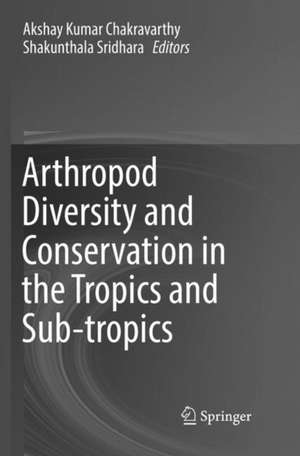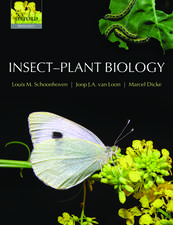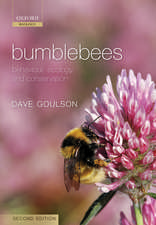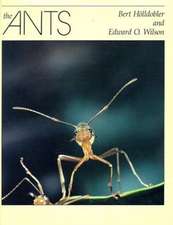Arthropod Diversity and Conservation in the Tropics and Sub-tropics
Editat de Akshay Kumar Chakravarthy, Shakunthala Sridharaen Limba Engleză Paperback – 10 iul 2018
Arthropods play an important role in maintaining the health of ecosystems, provide livelihoods and nutrition to human communities, and are important indicators of environmental change. Yet the population trends of several arthropods species show them to be in decline. Arthropods constitute a dominant group with 1.2 million species influencing earth’s biodiversity. Among arthropods, insects are predominant, with ca. 1 million species and having evolved some 350 million years ago. Arthropods are closely associated with living and non-living entities alike, making the ecosystem services they provide crucially important. In order to be effective, plans for the conservation of arthropods and ecosystems should include a mixture of strategies like protecting key habitats and genomic studies to formulate relevant policies for in situ and ex situ conservation.
This two-volume book focuses on capturing the essentials of arthropod inventories, biology, and conservation.Further, it seeks to identify the mechanisms by which arthropod populations can be sustained in terrestrial and aquatic ecosystems, and by means of which certain problematic species be managed without producing harmful environmental side-effects.
This edited compilation includes chapters contributed by over 80 biologists on a wide range of topics embracing the diversity, distribution, utility and conservation of arthropods and select groups of insect taxa. More importantly, it describes in detail the mechanisms of sustaining arthropod ecosystems, services and populations. It addresses the contribution of modern biological tools such as molecular and genetic techniques regulating gene expression, as well as conventional, indigenous practices in arthropod conservation. The contributors reiterate the importance of documenting and understanding the biology of arthropods from a holistic perspective before addressing conservation issues at large. This book offers a valuable resource for all zoologists, entomologists, ecologists, conservation biologists, policy makers, teachers and students interested in the conservation of biological resources.
| Toate formatele și edițiile | Preț | Express |
|---|---|---|
| Paperback (1) | 952.26 lei 6-8 săpt. | |
| Springer Nature Singapore – 10 iul 2018 | 952.26 lei 6-8 săpt. | |
| Hardback (1) | 958.38 lei 6-8 săpt. | |
| Springer Nature Singapore – dec 2016 | 958.38 lei 6-8 săpt. |
Preț: 952.26 lei
Preț vechi: 1161.29 lei
-18% Nou
Puncte Express: 1428
Preț estimativ în valută:
182.27€ • 198.06$ • 153.21£
182.27€ • 198.06$ • 153.21£
Carte tipărită la comandă
Livrare economică 21 aprilie-05 mai
Preluare comenzi: 021 569.72.76
Specificații
ISBN-13: 9789811093739
ISBN-10: 9811093733
Ilustrații: XXIV, 435 p. 149 illus., 101 illus. in color.
Dimensiuni: 155 x 235 mm
Greutate: 0.64 kg
Ediția:Softcover reprint of the original 1st ed. 2016
Editura: Springer Nature Singapore
Colecția Springer
Locul publicării:Singapore, Singapore
ISBN-10: 9811093733
Ilustrații: XXIV, 435 p. 149 illus., 101 illus. in color.
Dimensiuni: 155 x 235 mm
Greutate: 0.64 kg
Ediția:Softcover reprint of the original 1st ed. 2016
Editura: Springer Nature Singapore
Colecția Springer
Locul publicării:Singapore, Singapore
Cuprins
1. Impact of Climate Change on Arthropod Diversity
N. R. Prasannakumar and K. P. Kumar
2. Bioprospecting Arthropod Biomolecules: Amalgamation of novel compounds with new approaches
Anudita, V. Varunrajan and B. M. Deepa
3. Conservation of Arthropod parasites: Restoring Crucial Ecological Linkages
M. Jayashankar, S. R. Amulya Prasad and Subhash B. Kandakoor
4. Diversity and Ecology of Scorpions: Evolutionary success through venoms!
Shakunthala Sridhara, A.K. Chakravarthy , V. Kalarani and D. Chandrasekhar Reddy
5. An Overview of Crustacean Diversity In Mangrove Ecosystem
S. Murugan and D. Usha Anandhi
6. Phylogenetic Status, Diversity, Economic and Medicinal Importance of Crabs
V. Kalarani, V. Sumathi, V. Sridevi and D.C. Reddy
<
7. Millipedes: Diversity, Distribution and Ecology
Periasamy Alagesan
8. Spiders: Diversity, Distribution and Conservation
Ganesh Wankhede, Priyanka Hadole and A. K. Chakravarthy
9. Brown Mite Fluctuation, Bryobia rubrioculus (Scheuten) (Acari: Tetranychidae) in Cherry Orchards in Hamedan, Western Iran
Mohammad Khanjani
10. Coconut water as a promising culture media for Hirsutella thompsonii Fisher, a pathogen of coconut mite
Chandrika Mohan, M. K. Radhika, A. Josephrajkumar, and P. Rajan
11. Cladocerans: Diversity, Distribution, Ecological Significance
M. Karuthapandi and D. V. Rao
12. Diversity and Distribution of Sphecoid Wasps in Kerala, India: Bio-indicators of Habitat Quality
Baaby Job and J. L. Olakkengils
13. Diversity and Distribution of Chalcid wasps in Kerala: Key Biological control agents in Cultivated Ecosystems
N. Preethi and P. Lakshmi Devi Menon
14. Diversity of Economically Important Indian Microgastrinae (Hymenoptera: Braconidae) with New Records from India
Ankita Gupta
15. A Study on the Diversity and Distribution of genus Camponotus Mayr (Hymenoptera: Formicidae) in Kerala: Ecologically Significant Agents in Ecosystem Functioning
Presty John and K. A. Karmaly
16. Diversity of Tephritid Flies in Sub-Himalayan Region of West Bengal: Baseline Data for developing rational Management Practices
Nripendra Laskar, Dipak Kumar Sinha, Tapan Kumar Hath and Hirak Chatterjee
17. Diversity of Soft Scale Insects (Hemiptera: Sternorrhyncha: Coccoidea) in Sri Lanka
U. G. A. I. Sirisena, G. W. Watson, K. S. Hemachandra and H. N. P. Wijayagunasekara
18. Insect Conservation: A Synthetsis of management approaches
RiteshInamke, Deepak Panpatte, Noushad Parvez, Leena Pathak, Ankit Patel, Kuldeep Khatri and Janardan Jani
19. Gaint moths and their conservation
P. P. Mary, Vasudev Kammar, A. T. Rani and K. R. Yathish
20. Biological characteristics of Arrhenotokous and Thelytokous Trichogramma Riley: enhancing efficiency of Parasitization
T. Prabhulinga, S. K. Jalali, Kumar K. P. and B. Doddabasappa
21. Faunal Composition of Scarab Beetles and their Hosts in Assam
Mrinmoy Das, Badal Bhattacharya, D. Pujari and G Handique
22. Honey Bees and Beekeeping: the Global scenarioD. P. Abrol, Uma Shankar, K. S. Nitin and G. Basana Gowda
23. Nominating the Bee Trees of Nandagudi / Ramagovindapura as a World Heritage Site
Stephen Petersen and Muniswamyreddy Shankar Reddy
24. Requirements for Sustainable Management of Apis dorsata Fab. with Rafter Method
Stephen Petersen and Muniswamyreddy Shankar Reddy<
25. RNA interference: History, Mechanisms and Applications in Pest Management
Subba Palli Reddy
26. Optimization of Fermentation Parameters and In Vitro Efficacy of native Bacillus thuringiensisIsolates against Spodoptera lituraRahul Amin, Kuldeep Khatri, Deepak Panpatte, Leena Pathak, Ankit Patel, Noushad Parvez, Harsha Shelat, Janardan Jani and Rajababu Vyas
N. R. Prasannakumar and K. P. Kumar
2. Bioprospecting Arthropod Biomolecules: Amalgamation of novel compounds with new approaches
Anudita, V. Varunrajan and B. M. Deepa
3. Conservation of Arthropod parasites: Restoring Crucial Ecological Linkages
M. Jayashankar, S. R. Amulya Prasad and Subhash B. Kandakoor
4. Diversity and Ecology of Scorpions: Evolutionary success through venoms!
Shakunthala Sridhara, A.K. Chakravarthy , V. Kalarani and D. Chandrasekhar Reddy
5. An Overview of Crustacean Diversity In Mangrove Ecosystem
S. Murugan and D. Usha Anandhi
6. Phylogenetic Status, Diversity, Economic and Medicinal Importance of Crabs
V. Kalarani, V. Sumathi, V. Sridevi and D.C. Reddy
<
7. Millipedes: Diversity, Distribution and Ecology
Periasamy Alagesan
8. Spiders: Diversity, Distribution and Conservation
Ganesh Wankhede, Priyanka Hadole and A. K. Chakravarthy
9. Brown Mite Fluctuation, Bryobia rubrioculus (Scheuten) (Acari: Tetranychidae) in Cherry Orchards in Hamedan, Western Iran
Mohammad Khanjani
10. Coconut water as a promising culture media for Hirsutella thompsonii Fisher, a pathogen of coconut mite
Chandrika Mohan, M. K. Radhika, A. Josephrajkumar, and P. Rajan
11. Cladocerans: Diversity, Distribution, Ecological Significance
M. Karuthapandi and D. V. Rao
12. Diversity and Distribution of Sphecoid Wasps in Kerala, India: Bio-indicators of Habitat Quality
Baaby Job and J. L. Olakkengils
13. Diversity and Distribution of Chalcid wasps in Kerala: Key Biological control agents in Cultivated Ecosystems
N. Preethi and P. Lakshmi Devi Menon
14. Diversity of Economically Important Indian Microgastrinae (Hymenoptera: Braconidae) with New Records from India
Ankita Gupta
15. A Study on the Diversity and Distribution of genus Camponotus Mayr (Hymenoptera: Formicidae) in Kerala: Ecologically Significant Agents in Ecosystem Functioning
Presty John and K. A. Karmaly
16. Diversity of Tephritid Flies in Sub-Himalayan Region of West Bengal: Baseline Data for developing rational Management Practices
Nripendra Laskar, Dipak Kumar Sinha, Tapan Kumar Hath and Hirak Chatterjee
17. Diversity of Soft Scale Insects (Hemiptera: Sternorrhyncha: Coccoidea) in Sri Lanka
U. G. A. I. Sirisena, G. W. Watson, K. S. Hemachandra and H. N. P. Wijayagunasekara
18. Insect Conservation: A Synthetsis of management approaches
RiteshInamke, Deepak Panpatte, Noushad Parvez, Leena Pathak, Ankit Patel, Kuldeep Khatri and Janardan Jani
19. Gaint moths and their conservation
P. P. Mary, Vasudev Kammar, A. T. Rani and K. R. Yathish
20. Biological characteristics of Arrhenotokous and Thelytokous Trichogramma Riley: enhancing efficiency of Parasitization
T. Prabhulinga, S. K. Jalali, Kumar K. P. and B. Doddabasappa
21. Faunal Composition of Scarab Beetles and their Hosts in Assam
Mrinmoy Das, Badal Bhattacharya, D. Pujari and G Handique
22. Honey Bees and Beekeeping: the Global scenarioD. P. Abrol, Uma Shankar, K. S. Nitin and G. Basana Gowda
23. Nominating the Bee Trees of Nandagudi / Ramagovindapura as a World Heritage Site
Stephen Petersen and Muniswamyreddy Shankar Reddy
24. Requirements for Sustainable Management of Apis dorsata Fab. with Rafter Method
Stephen Petersen and Muniswamyreddy Shankar Reddy<
25. RNA interference: History, Mechanisms and Applications in Pest Management
Subba Palli Reddy
26. Optimization of Fermentation Parameters and In Vitro Efficacy of native Bacillus thuringiensisIsolates against Spodoptera lituraRahul Amin, Kuldeep Khatri, Deepak Panpatte, Leena Pathak, Ankit Patel, Noushad Parvez, Harsha Shelat, Janardan Jani and Rajababu Vyas
Notă biografică
Dr. A.K.Chakravarthy, Head, Principal Scientist, Division of Entomology and Nematology is an author of many books and over 300 scientific papers and 25 chapters in Entomology and natural history. His interest includes Insects, birds, bats, rodents and mammals. With over three decades of experience of teaching, research and extension. Dr. Chakravarthy has been the investigator for over 30 research projects and has guided more than 20 students for post graduation. A PhD, from Punjab Agriculture University and Fellow from IARI, New Delhi, he is a member of several National and International scientific academia, an advisor, a panelist, a referee, reviewer, editor and he is associated with publication of several national and international journals worldwide. A field orientated, widely travelled biologist, he is actively working on novel approaches in Integrated Pest management, Host Plant Interaction, vertebrate pest management, Biodiversity and environmental conservation issues. Recently he has published a book entitled “New Horizons in Insect Science: Towards Sustainable Pest Management” with springer, the book will ready by January, 2015.
Professor Shakunthala Sridhara obtained her B.Sc (1967)., M.Sc. (1969) and Ph.D.(1973) from Bangalore University, Bangalore. In late 1973 she joined the University of Agricultural Sciences, Bangalore. From 1973 to 2007 she taught and carried out research on plant protection. After retiring as Professor and Head, Dr. Sridhara was selected as Emeritus Scientist of Indian Council of Agricultural research, New Delhi for a period of two years. (May 2007 to April 2009). Currently she is a consultant to pesticide companies and is also busy writing scientific books for reputed national and international publishers.
During her 38 years of research, Dr. Sridhara has published 132 research papers, participated and presented 87 research papers in national and international conferences in United Kingdom, USA, Austria, Germany, Spain and Hawai. So far she has published ten books on pest management in agricultural systems including arthropods.
Professor Shakunthala Sridhara obtained her B.Sc (1967)., M.Sc. (1969) and Ph.D.(1973) from Bangalore University, Bangalore. In late 1973 she joined the University of Agricultural Sciences, Bangalore. From 1973 to 2007 she taught and carried out research on plant protection. After retiring as Professor and Head, Dr. Sridhara was selected as Emeritus Scientist of Indian Council of Agricultural research, New Delhi for a period of two years. (May 2007 to April 2009). Currently she is a consultant to pesticide companies and is also busy writing scientific books for reputed national and international publishers.
During her 38 years of research, Dr. Sridhara has published 132 research papers, participated and presented 87 research papers in national and international conferences in United Kingdom, USA, Austria, Germany, Spain and Hawai. So far she has published ten books on pest management in agricultural systems including arthropods.
Textul de pe ultima copertă
Arthropods are invertebrates that constitute over 90% of the animal kingdom, and their bio-ecology is closely linked with global functioning and survival.
Arthropods play an important role in maintaining the health of ecosystems, provide livelihoods and nutrition to human communities, and are important indicators of environmental change. Yet the population trends of several arthropods species show them to be in decline. Arthropods constitute a dominant group with 1.2 million species influencing earth’s biodiversity. Among arthropods, insects are predominant, with ca. 1 million species and having evolved some 350 million years ago. Arthropods are closely associated with living and non-living entities alike, making the ecosystem services they provide crucially important. In order to be effective, plans for the conservation of arthropods and ecosystems should include a mixture of strategies like protecting key habitats and genomic studies to formulate relevant policies for in situ and ex situ conservation.
This two-volume book focuses on capturing the essentials of arthropod inventories, biology, and conservation. Further, it seeks to identify the mechanisms by which arthropod populations can be sustained in terrestrial and aquatic ecosystems, and by means of which certain problematic species be managed without producing harmful environmental side-effects.
This edited compilation includes chapters contributed by over 80 biologists on a wide range of topics embracing the diversity, distribution, utility and conservation of arthropods and select groups of insect taxa. More importantly, it describes in detail the mechanisms of sustaining arthropod ecosystems, services and populations. It addresses the contribution of modern biological tools such as molecular and genetic techniques regulating gene expression, as well as conventional, indigenous practices in arthropod conservation. The contributors reiterate the importance of documenting and understanding the biology of arthropods from a holistic perspective before addressing conservation issues at large. This book offers a valuable resource for all zoologists, entomologists, ecologists, conservation biologists, policy makers, teachers and students interested in the conservation of biological resources.
Arthropods play an important role in maintaining the health of ecosystems, provide livelihoods and nutrition to human communities, and are important indicators of environmental change. Yet the population trends of several arthropods species show them to be in decline. Arthropods constitute a dominant group with 1.2 million species influencing earth’s biodiversity. Among arthropods, insects are predominant, with ca. 1 million species and having evolved some 350 million years ago. Arthropods are closely associated with living and non-living entities alike, making the ecosystem services they provide crucially important. In order to be effective, plans for the conservation of arthropods and ecosystems should include a mixture of strategies like protecting key habitats and genomic studies to formulate relevant policies for in situ and ex situ conservation.
This two-volume book focuses on capturing the essentials of arthropod inventories, biology, and conservation. Further, it seeks to identify the mechanisms by which arthropod populations can be sustained in terrestrial and aquatic ecosystems, and by means of which certain problematic species be managed without producing harmful environmental side-effects.
This edited compilation includes chapters contributed by over 80 biologists on a wide range of topics embracing the diversity, distribution, utility and conservation of arthropods and select groups of insect taxa. More importantly, it describes in detail the mechanisms of sustaining arthropod ecosystems, services and populations. It addresses the contribution of modern biological tools such as molecular and genetic techniques regulating gene expression, as well as conventional, indigenous practices in arthropod conservation. The contributors reiterate the importance of documenting and understanding the biology of arthropods from a holistic perspective before addressing conservation issues at large. This book offers a valuable resource for all zoologists, entomologists, ecologists, conservation biologists, policy makers, teachers and students interested in the conservation of biological resources.
Caracteristici
Complies state-of-the-art research of eminent entomologists in the fields of arthropod biodiversity and conservation
Covers the cutting edge technologies facilitating ecosystem by arthropods in wild and cultivated habitats
Bridges the gap in arthropod and ecosystem services research by contemporary information
Includes supplementary material: sn.pub/extras
Covers the cutting edge technologies facilitating ecosystem by arthropods in wild and cultivated habitats
Bridges the gap in arthropod and ecosystem services research by contemporary information
Includes supplementary material: sn.pub/extras
















